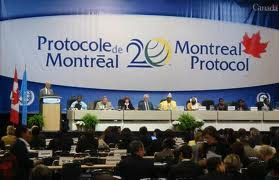The last time the world got together to implement a global environmental treaty was the Montreal Protocol, which is turning out to be our best weapon against climate change.
China has agreed to accept $385 million to completely eliminate industrial production of HCFCs by 2030 from the Montreal Protocol’s Multilateral Fund.
China is the top producer of HCFCs – industrial gases used in refrigeration, air conditioning, and insulating foams that both warm the climate and destroy the ozone layer.
Developed nations contribute to the Multilateral Fund to pay "incremental costs" for developing countries to transition from harmful HCFCs to environmentally responsible substitutes.
"The Montreal Protocol once again demonstrated how important it is for climate protection by striking a deal with China to cut the equivalent of 8 billion tons of carbon emissions – for the bargain basement price of less than 5 cents a ton," says Durwood Zaelke, President of the Institute for Governance & Sustainable Development. "This is about the same climate mitigation as all the parties to the Kyoto Protocol have achieved through the first phase of that treaty."

Eliminating these climate forcers will also protect the stratospheric ozone layer, reducing skin cancers, cataracts, and suppression of the human immune system. And it will cut air pollution, the leading cause of preventable death in China and the region.
If HFCs and other potent GHGs are eliminated quickly (black carbon, methane, ground-level ozone), the rate of global warming would be cut IN HALF, keeping global temperature rise under the dreaded 2°C through the end of the century – and perhaps less than that. And it would slow Arctic ice melt by two-thirds.
Unlike CO2, which can remain in the atmosphere for centuries, these pollutants last only days to weeks in the atmosphere, but they are hundreds to thousands of times more potent than carbon.
HFCs were allowed as a temporary replacement for CHFC, which were outlawed in the original Montreal Protocol to protect the ozone layer. CHFCs are being successfully phased out, and now HFCs are rising rapidly in the atmosphere, threatening to push the climate system past the 2°C outer limit.
"HFCs present the biggest, fastest piece of climate mitigation available to the world in the next few years," says Zaelke.
A couple of years ago, the US, Canada and Mexico filed formal proposals to phase down HFCs but heavy lobbying from the chemical industry in India and China influenced their positions and they rejected it.
Agreement on the HFC proposal will reduce climate emissions equivalent to 100 billion tons of carbon emissions!
A consortium of over 400 companies, including Unilever, Tesco, Coca-Cola and Walmart, agreed to stop using HFCs in 2015. Natural refrigeration solutions exist today, using hydrocarbons, ammonia and carbon dioxide.
By 2015, the US will cut production and imports of HCFC-22 to 10% of levels from 10 years ago.
To get a sense of the difficulties of getting HFCs removed from everyday life, read our article, HFCs Lurking in Your Air Conditioning System?
Read our article, Five-Point Plan Announced to Quickly Reduce Climate Forcers.
